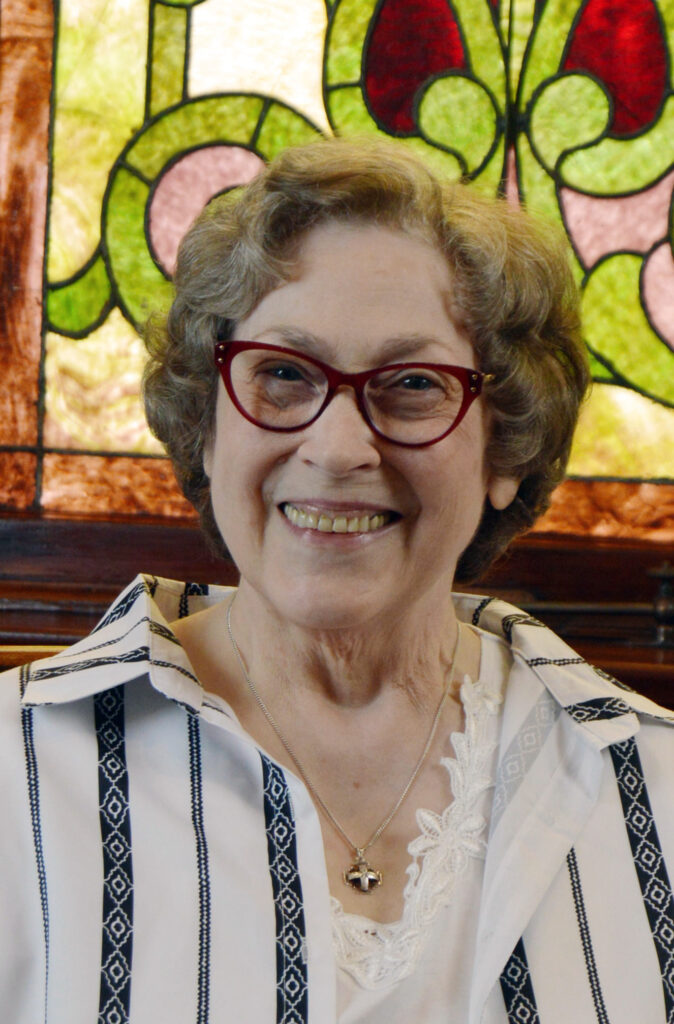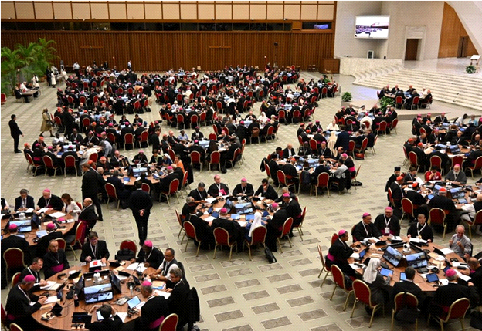By Sister of St. Joseph, Catherine Michaud, Ph.D.

The plan for a synodal Church germinated during Vatican Council II (October 1962–December 1965) when there was not yet a term for it. At first, the Council used the word “collegiality” to describe a new style of leadership involving cooperation and sharing of the Church’s ministries and leadership responsibilities among the baptized members, especially between the Laity and the Hierarchy. Foundational to the new style of leadership was a new self-identity for baptized Catholics that has been slow to develop. Before Vatican II, the predominating and deeply entrenched “institutional model” of Church held that Holy Orders was the preeminent sacrament, and “Church” was identified in many people’s minds as the Hierarchy—the ordained members, not the “simple faithful” in the pews. The clergy were charged with teaching, preaching, dispensing sacraments, and administering church authority.
Shortly after the Council’s conclusion in December of 1965, Belgian Cardinal Leo Suenens, one of the most important authors of The Dogmatic Constitution on the Church, declared that the two richest elements of the Council’s renewal were (1) establishing the Church’s self-identity as the “People of God” and (2) acknowledging the co-responsibility in Christ’s mission among all its members (Noceti and Luciani, NCR, March 17, 2023).
The Council led Catholics to the realization that the Sacrament of Baptism is chief among the sacraments, not Holy Orders. Through our baptisms, we receive our identity as God’s children and our mission as Christ’s disciples to complete the work of bringing about God’s Kingdom on Earth. Our baptisms anoint us as members of the “communion of equals,” Christ’s Body that St. Paul describes in his epistles: “As a body is one though it has many parts, and all the parts of the body, though many, are one body, so also Christ. For in one Spirit, we were all baptized into one body, whether Jews or Greeks, slaves or free persons, and we were all given to drink of one Spirit (1 Corinthians 12:12-13).
The Council’s hope was to shift the Church’s self-identity from predominantly the “institution” model to a “communion” constituted by the Holy Spirit. Pope Francis, however, reclaims the institutional model as a “new institutional model” using communicative dynamics: “. . . a synodal Church is a Church of listening . . . It is a reciprocal listening in which everyone has something to learn . . .
It is listening to God, to the point of listening with him to the cry of the people; and it is listening to the people, to the point of breathing in them the will to which God calls us” (Noceti and Luciani, “Pope Francis Seeks a Synodal Church,” NCR, March 17, 2023).
The exercise of “listening” is indispensable to the synodal church that Pope Francis seeks: “It starts from recognition of the identity and the proper contribution of each ecclesial subject—laity, priests, religious, bishops and pope” (Noceti and Luciani, NCR, March 17, 2023).
Participants in the synodal meetings in parishes and dioceses around the world, and ultimately the delegates at the Vatican, have gathered around tables in small groups for listening, discernment, and dialogue. Each of these stages—the repeated moments in the process—is preceded and followed by periods of prayer. In this way, issues that currently impede our full and effective participation in our baptismal mandates to live as members of the Christian community are openly and prayerfully addressed, according to each person’s experience. The manner of listening at each stage of the synod process is critical: each voice must be received as the voice of the Spirit speaking to the Church, and each sharing is received as content for discernment, not so much for analysis and discussion, for, as Cardinal Walter Kasper has said, “A synod is not a congress of theologians. It is intended to allow the people of God with their different experiences of faith and yet also with their common sense of faith (sensus fidei) given in baptism to have their say.” The synod is not a parliamentary-style proceeding with a legislative agenda. Participants in the synodal process are reminded that the “main speaker” is the Holy Spirit (Cardinal Walter Kasper, Communio, 10-31-2024).

View of the Synod Hall at the Vatican © Paul Wuthe / Kathpress published in Communio: Theology and Church, 31.10.2024
Opening the synod in October 2021, the Pope was already aware that a process like this takes time in order to “master the art of encounter.” Early on, he acknowledged the learning curve that the Church had to navigate. Still, he saw the process as an effort to help the Christian community reflect the “style of God, who travels the paths of history and shares in the life of humanity.” The episcopal conferences from around the world, after participating in the first diocesan synodal phase reflected that the future synods would be experienced as ‘a journey within the journey’ to foster more mature reflection for the greater good of the Church” (C. White, NCR, 10-16-22).
On October 16, 2022, Pope Francis announced that he intended to significantly expand the timeframe for his ongoing consultation process for the world’s Catholics. This would involve discussions with Catholics across the world on a range of sensitive topics. His announcement indicated his desire that the process and the discussions should continue much longer than formerly planned. He reported with great optimism that the fruits of the synodal process already begun are many, “but in order for them to bear much fruit, we can’t hurry.” He added that extending the process was an effort “to help make synodality part of the ‘constitutive nature of the church.'” This means that synodality should be as much an identifying characteristic of the Church as the concept of the magisterium or the tradition of social justice. It is an essential element of the Church of Vatican Council II. Synodality is a path that enables the church to be more “participatory and missionary” and “can no longer be considered a curiosity, a practice to be dabbled in or a passing fad. Rather, it is essential to how the church understands itself”
(Martin, America, 10-26-24).
Pope Francis planned that the first gathering of synod delegates would take place in Rome October 4–29, 2023. The Vatican put the plan in motion to considerably widen the process: it would involve a phased two-year listening process with consultation stages at both the diocesan and continental levels in preparation for the full assemblies in Rome with representatives and bishops from around the world. Cardinal Mario Grech, the head of the synod office, said that this plan was an effort to change the synod “from an event into a process.” His office and the synod advisors drafted working documents at the conclusion of synodal meetings in preparation for the next phases of the process. These documents are available to the whole Church. Indeed, the work of the individual dioceses who have participated in the Synod on Synodality have made the texts of their listening sessions available also. Common themes—areas of need for the Church’s attention—have emerged: social justice, environmental justice, the Church’s role in areas of global conflict, the role of women and full acceptance of their baptisms, care for the poor and for refugees, and L.G.B.T.Q. issues among others.(C. White, “Pope Francis Extends Synod,” NCR, 10-16-22).
Having participated in the Synod on Synodality for the past three years, Cardinal Walter Kasper has reflected that “The synodal method proved to be a pleasant alternative to aggressive debates and all the lack of culture that prevails today in political and, unfortunately, also in church debates. In the end, only supposed victors and humiliated, wounded defeated remain. At the synod, we were able to set off synodally, i.e., together, with an overwhelming majority” (Cardinal Walter Kasper, Communio, 10-31-2024).
Forward Steps and Open Questions
The final document, For a Synodal Church: Communion, Participation, Mission, available following the October 2024 Synod Assembly in Rome, highlights some definite advances in consciousness and articulation of needs in the Church for ongoing reform, for continuing discernment and discussion, and for trust in the Holy Spirit at work in the Church.
https://www.synod.va/content/dam/synod/news/2024-10-26_final-document/ENG—Documento-finale.pdf
Among the clear awarenesses resulting from the Synod launched in October 2021 are these:
1) The clergy are called to be listeners as Vatican II prescribed: “In fulfilling their office as shepherd, pastors should take pains to know their own flock. Since they are the servants of all the sheep, they should encourage a full Christian life among the individual faithful and also in families. . . . Finally, they should encourage the faithful to assist in the works of the apostolate” (Christus Dominus 30).
The Synod recommends that pastors and parishes in general consider instituting a “ministry of listening and accompaniment” and that decisions affecting the life of the Church be always the result of consultation and discernment.
2) Parishes and dioceses should be organized as consultative bodies with parish councils, pastoral councils, diocesan synods, and other assemblies where the voices of the members of the Body of Christ can be heard. How else shall the Holy Spirit be allowed to speak?
3) Because it is clear that the Holy Spirit is active and alive in all the People of God—not simply in cardinals, archbishops, bishops, and priests, but at all levels of the Church, the procedures for listening and discernment outlined in the Final Document must be installed. This extends to all levels of the church, including future synods—as the Synod delegates recommended, as this Synod did for the first time, to include not simply bishops but “other members of the People of God” (Paragraph no. 136).
Among the issues awaiting further prayer, listening, discussion, and discernment are
1) The place of women; this is a central theme to the document overall; it has been an almost constant theme in the discussions over the last two years.
2) The ordination of women to the diaconate.
3) The ordaining of married men to the priesthood.
4) L.G.B.T.Q. issues: We ask the Church to listen to those who “experience the pain of feeling excluded or judged, because of their marital situation, identity or sexuality” (Paragraph no. 50).
A number of these concerns have been handed over to the 10 “study groups” for further discernment. They are evidence of why the Synod participants recommended that the synodal process continues. There is work to be done.
To conclude, Pope Francis has successfully set in motion the “synodality” that should have taken place 60 years ago as Vatican Council II was finishing its deliberations. For the past three years, Catholics the world over have been participating in synods that were intended to deliver the aggiornamento (bringing up to date) and renovatio ecclesiae (church reform) from the Council chambers to the dioceses and parishes everywhere. Some Catholics are wondering if it is too late to implement this core element of the Council’s work, but we must take heart, first, that the Spirit who conceived the Church is still its breath of life, and second, that the full reception of directives enacted by ecumenical councils can take 100 years. Pope Francis has dared to trust in the Spirit who began this work six decades ago to continue it in our time. When an inspiration genuinely comes from the Holy Spirit, it endures; the Spirit who is trustworthy continues to work.